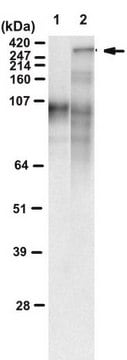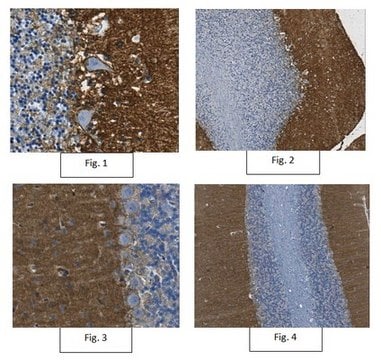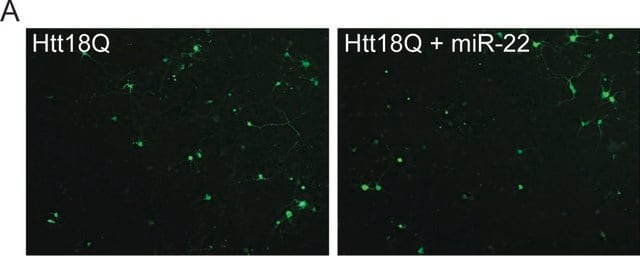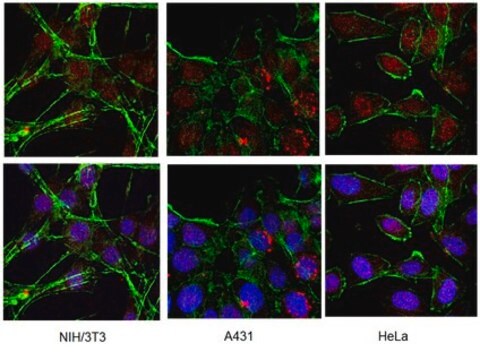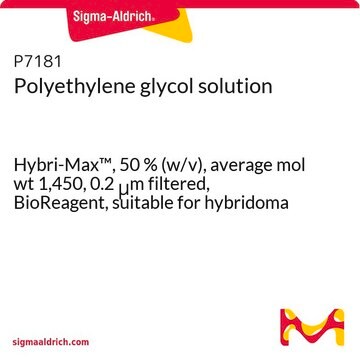MABN821
Anti-polyQ Disease Proteins Antibody, clone 3B5H10
clone 3B5H10, from mouse
Sinónimos:
Huntingtin mutants with expanded polyQ repeats, HD protein, Huntington disease protein, mHtt, PolyQ disease proteins
About This Item
Productos recomendados
biological source
mouse
Quality Level
antibody form
purified antibody
antibody product type
primary antibodies
clone
3B5H10, monoclonal
species reactivity
human
technique(s)
electron microscopy: suitable
immunocytochemistry: suitable
immunohistochemistry: suitable
inhibition assay: suitable
western blot: suitable
isotype
IgG1
UniProt accession no.
shipped in
ambient
target post-translational modification
unmodified
Gene Information
human ... HTT(3064)
General description
Specificity
Immunogen
Application
Immunocytochemistry Analysis: A representative lot immunostained neurons transiently expressing Huntington (Htt) or Ataxin-3 with disease-associated polyQ expansions (Q46 to Q138), but not neurons expressing Htt with Q17 or Ataxin-3 with Q27. Clone 3B5H10 stained diffuse mutant Htt (mHtt), but not aggregated Htt in large inclusion bodies (IBs) (Miller, J., et al. (2011). Nat. Chem. Biol. 7(12):925-934).
Immunohistochemistry Analysis: A representative lot immunostained brain tissue sections from transgenic mice expressing disease-associated human mutant Huntinton (mHtt) proteins, including murine strains BACHD (full-length mHtt with Q97), R6/2 (Exon 1 fragment with ~Q150), and YAC-SCA3 (full-length mHtt with Q84). Clone 3B5H10 stained diffuse mHtt and failed to stain tissue with extensively aggregated Htt unless strong antigen retrieval by 90% formic acid treatment was performed (Miller, J., et al. (2011). Nat. Chem. Biol. 7(12):925-934).
Inhibition Analysis: A representative lot prevented the aggregation of mutant Htt (mHtt) exon 1 fragment with Q39 or Q53 and disrupted pre-aggregated mHtt oligomers and fibrils into monomer in vitro by atomic force microscopy (AFM) and dynamic light scattering (DLS) measurement (Miller, J., et al. (2011). Nat. Chem. Biol. 7(12):925-934).
Western Blotting Analysis: A representative lot detected Huntington (Htt), androgen receptor (AR), and atrophin constructs with disease-associated polyQ expansions (Q65 to Q103), but not constructs with Q19 or Q25, exogenously expressed in HEK293 and PC12 cells. Clone 3B5H10 detected monomeric and possibly small oligomeric mHtt N-terminal fragments, but not large oligomers or high molecular weight aggregates (Miller, J., et al. (2011). Nat. Chem. Biol. 7(12):925-934).
Quality
Western Blotting Analysis: 0.5 µg/mL of this antibody detected exon 1-coded N-terminal Huntington fragment with 134-glutamine/Gln (134Q) expansion, but not the corresponding normal (wild-type) fragment with 17Qs.
Target description
Physical form
Other Notes
Not finding the right product?
Try our Herramienta de selección de productos.
Optional
Storage Class
12 - Non Combustible Liquids
wgk_germany
WGK 1
Certificados de análisis (COA)
Busque Certificados de análisis (COA) introduciendo el número de lote del producto. Los números de lote se encuentran en la etiqueta del producto después de las palabras «Lot» o «Batch»
¿Ya tiene este producto?
Encuentre la documentación para los productos que ha comprado recientemente en la Biblioteca de documentos.
Nuestro equipo de científicos tiene experiencia en todas las áreas de investigación: Ciencias de la vida, Ciencia de los materiales, Síntesis química, Cromatografía, Analítica y muchas otras.
Póngase en contacto con el Servicio técnico